
Markos Botsaris was a Souliot chieftain, general of the Greek revolutionary army and hero of the Greek War of Independence. He played a key role in relieving the First Siege of Missolonghi in 1822–1823 and was awarded the title of General of Western Greece by the revolutionary Greek government. He was killed during the Battle of Karpenisi and was buried in Missolonghi with full honors. Today Botsaris is among the most revered national heroes in Greece.

The armatoles, or armatole in singular, were irregular soldiers, or militia, commissioned by the Ottomans to enforce the sultan's authority within an administrative district called an armatoliki. In Greek regions of the Ottoman Empire, they were composed of Greeks who were either former klephts or village stalwarts who had taken up arms against the klephts in the defense of their district.

Andreas Metaxas was a Greek politician, fighter of the Greek War of Independence and diplomat from Cephalonia. He was prime minister of Greece from 3 September 1843 to 16 February 1844. Some military leaders of the revolution (Makriyannis) gave him the ironic nickname of "Conte Lalas'" due to his injury during the Battle of Lalas.

Georgios Karaiskakis, born Georgios Karaiskos, was a Greek military commander and a leader of the Greek War of Independence.

The First National Assembly of Epidaurus was the first meeting of the Greek National Assembly, a national representative political gathering of the Greek revolutionaries.
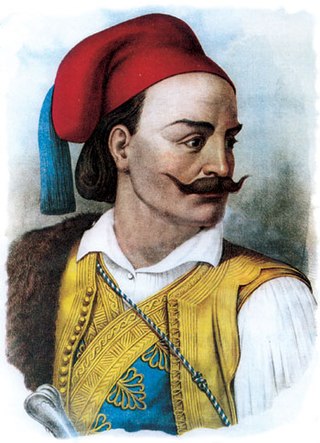
Kitsos Tzavelas was a Souliot fighter and general of the Greek rebels in the Greek War of Independence. After the establishment of the Kingdom of Greece he entered Greek politics and served as Minister of Military Affairs (1847-1848) and as Prime Minister (1847).

Anastasios Karatasos was a Greek military commander during the Greek War of Independence was born in the village of Dovras, Imathia and is considered to be the most important revolutionary from Macedonia.

Kyriakoulis Mavromichalis was a Greek revolutionary who fought in the Greek War of Independence.
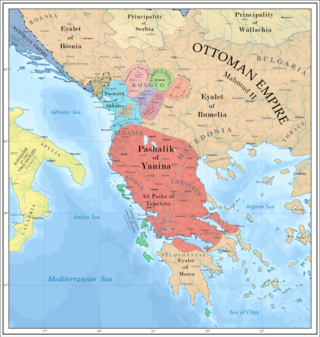
The Pashalik of Yanina, sometimes referred to as the Pashalik of Ioannina or Pashalik of Janina, was an autonomous pashalik within the Ottoman Empire between 1787 and 1822 covering large areas of Albania, Greece, and North Macedonia. Under the Ottoman Albanian ruler Ali Pasha, the pashalik acquired a high degree of autonomy and even managed to stay de facto independent, though this was never officially recognized by the Ottoman Empire. Conceiving his territory in increasingly independent terms, Ali Pasha's correspondence and foreign Western correspondence frequently refer to the territories under Ali's control as Albania.

The Battle of Peta or Battle of Petta was fought between the Greeks led by Alexandros Mavrokordatos with Markos Botsaris and the Ottomans led by Omer Vrioni on 16 July 1822. The conflict occurred on a hillside near the village of Peta in Epirus.
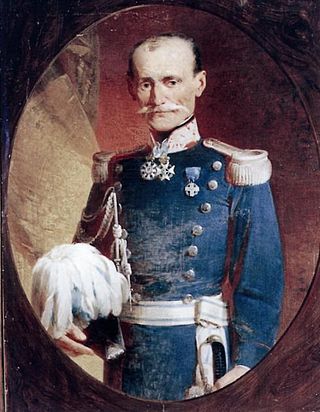
Kostas (Kitsos) Botsaris, also known as Constantine Botzaris, was a Greek general and senator. He was also a captain and a hero of the War of Greek Independence. He fought at the Battle of Karpenisi and completed the victory of his brother, the renowned Markos Botsaris.

The Souliotes were an Orthodox Christian Albanian tribal community in the area of Souli in Epirus from the 16th century to the beginning of the 19th century, who via their participation in the Greek War of Independence came to identify with the Greek nation.

Georgios Sekeris was a member of Filiki Eteria and a fighter of the Greek War of Independence. He was the first to be initiated into Filiki Eteria in Moscow by Nikolaos Skoufas in 1814.
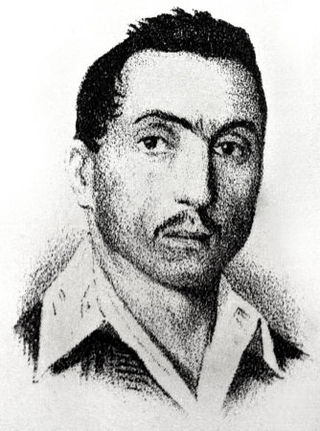
Christos Palaskas was a Greek chieftain during the Greek War of Independence. He was killed by Odysseas Androutsos’s men, during an internal conflict.

Ioannis or Yannakis Rangos was a Greek armatolos of the 19th century and fighter in the Greek War of Independence.
The Panellinion was the name given to the advisory body created on 23 April 1828 by Ioannis Kapodistrias, replacing the Legislative Body, as one of the terms he set to assume the governorship of the new country. The Panellinion was later replaced by the Senate during the Fourth National Assembly at Argos in July 1829. The body was named after the Panhellenion, a league of Greek city-states established by Emperor Hadrian.
A number of different and competing administrations used the name Administrative Committee(Greek: Διοικητική Επιτροπή) throughout 1832, each claiming responsibility for a different part of Greece, all after the dissolution of the Administrative Committee of 1831 of Augustinos Kapodistrias, Theodoros Kolokotronis, and Ioannis Kolettis and before the installation of King Otto of Greece.
The Greek Legion, officially the Light Jäger Foot Legion, was a Jäger infantry unit in the service of the Russian-controlled Septinsular Republic. It consisted of soldiers of Greek and Albanian origin and was led by Major-General Emmanouil Papadopoulos. It was active between 1805 and 1807, taking part in the War of the Third Coalition and the Russo-Turkish War (1806–1812).

The Souliote War was an armed conflict between Ali Pasha of Ioannina and a coalition of Souliotes and their Muslim allies. The war lasted between February 1789 and April 1793 and was fought in the context of the Russo-Turkish War (1787–1792) and local power struggles. The Souliotes achieved a defensive victory but their actions did not foment a Christian insurrection as the Russians had hoped.
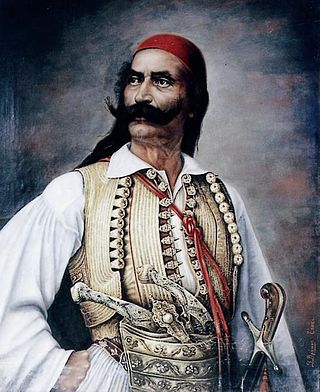
Georgios Drakos was a Souliot chieftain of the Greek War of Independence.


















